As the Royal West of England Academy – Bristol’s oldest art gallery – prepares to reopen its doors after many months under re-construction, we catch up with the gallery’s director, Alison Bevan, who takes us behind-the-scenes of the most significant restoration the RWA has seen in over a century…
Nine months in the making and the Royal West of England Academy (RWA) is just days away from reopening its doors to the general public, welcoming visitors back to its galleries for the first time this year. Until very recently, the £4.2 million refurbishment has been taking place behind tall wire fences and boarded windows but signs of progress have been beginning to break through the barriers.
The recent restoration of the Grade II* listed building is the most significant redevelopment the gallery has seen in over a century. The works have not only delivered urgent repairs to save the RWA from risk of permanent closure but have brought a number of major improvements to the art space, including free-to-access galleries on all three floors and an impressive new lift that can carry four wheelchair users and their carers. The innovative redesign also allows the city’s oldest gallery to welcome 40% more visitors each year.
Ahead of the official opening on 2 May, we were lucky enough to be given a sneak preview of the restoration works by RWA Director Alison Bevan. Alison has overseen every detail of the build, putting in thousands of hours to ensure the multi-million pound make-over is artfully completed, making it a space for all to enjoy.
As we step forth into the Academy on a particularly wet April afternoon – hard hats firmly fixed – we immediately begin to negotiate the construction site’s restrictive conditions – namely ladders, low-hanging wires and an army of workers. Although the gallery is stripped bare, it is utterly remarkable to see such a grand piece of architecture in such a raw state. The large metal platforms stand tall as if installations in their own right. Occasionally, we snatch a glimpse of some of the gallery’s famous features as they lay under protective hardwood, reminding us of just how architecturally important a place the Academy truly is.
Our first stop was the much-loved and much-missed café – or the room which will soon take its shape. The windows have been lowered to allow light to flood in, subsequently offering customers a better view of the prominent Victoria Rooms, which stand opposite. Large swinging doors have also been installed so refreshments can be enjoyed well into the evening when the gallery is closed. We’re eager to see its return.
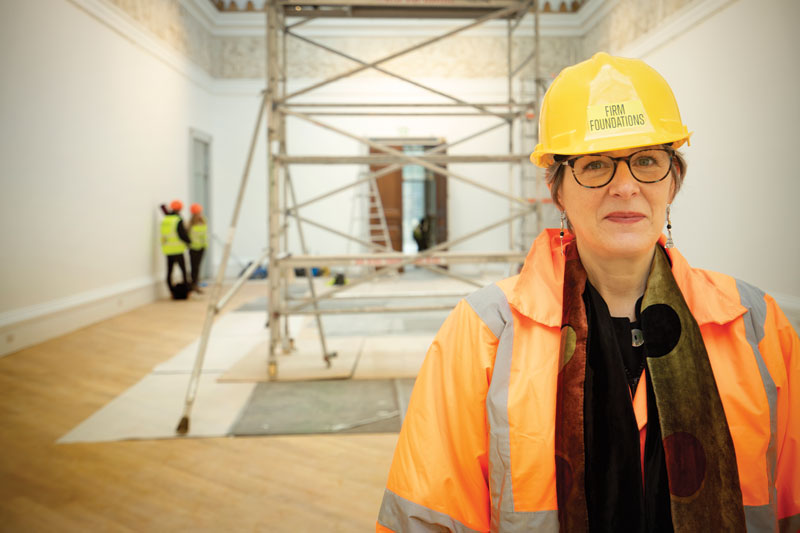
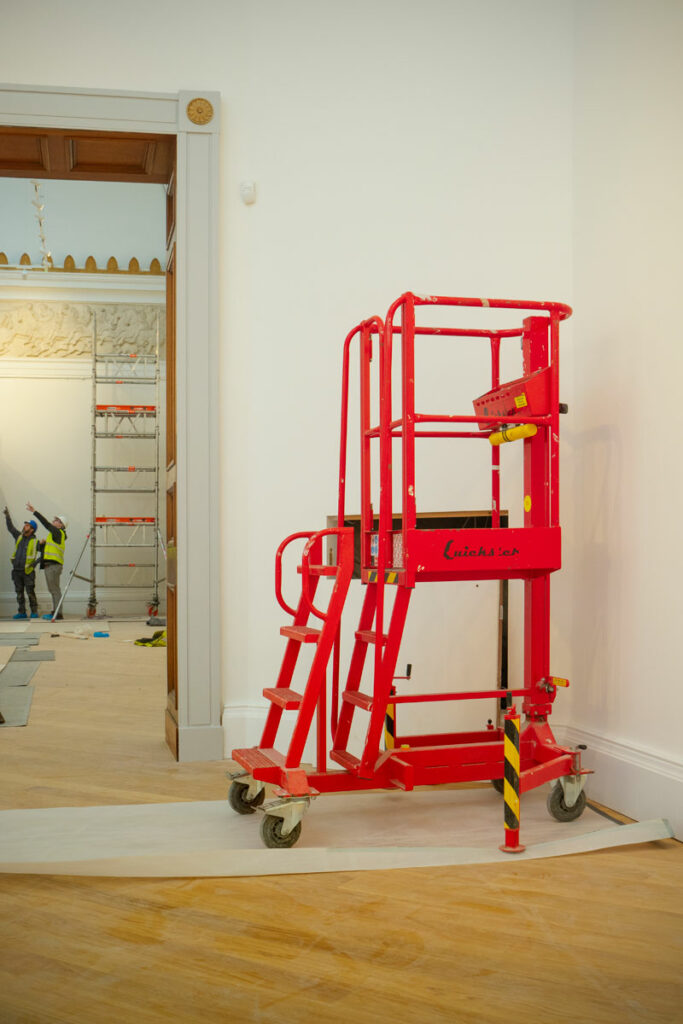
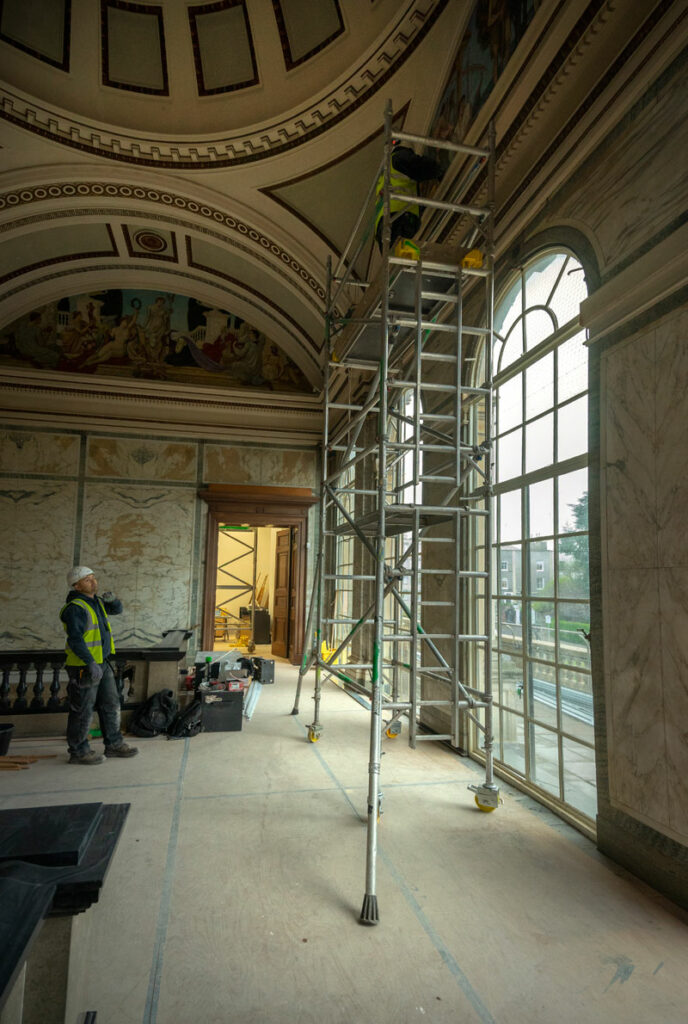
As we make our way up the beautiful marble-clad interior staircase, admiring the spectacular ceiling dome and lunettes as we go, we enter the main gallery on the first floor, where inconspicuous adjustments have been carried out with such precision and grace. Alison begins to explain: “All of the walls in this room have been back to the brick. We’ve taken off three layers of tongue and groove – and then replaced it with batten, then plywood, then plasterboard then replastered it to achieve these beautiful pristine walls.
“The windows have temperature-driven ventilation units so when it gets hot, they will automatically open and when they sense moisture, they will automatically close. It used to get up to 37 degrees celcius in here in the summer with the old roof lanterns so these windows are double glazed and 99.5% UV filtered. It will now be cooler in the summer and warmer in the winter.
“We also have new under floor heating. Every bit of pipe work and electrical cable in the building has been changed, so we have a 100% carbon-free fuel supply [complying with the city’s 2030 carbon neutral target]. We’ve got rid of our gas boilers and put in air-source heat pumps so our new heating systems are not just good for the RWA, but they’re good for the environment.”
From the windows to the walls and the Academy’s replica of the Parthenon Frieze, which runs above the picture rail. It shows the procession of the Panathenaic festival, the commemoration of the birthday of the goddess Athena, and is spectacular in every way. “The Parthenon Frieze has been cleaned,” Alison tells us as we lean in towards it. “By cleaning it, the lines of muscles on the horses have been uncovered for the first time in decades.”
As we move from one gallery to the next, subtle additions show that the gallery management team has not only listened to the feedback from its visitors and surrounding communities but it has ensured that the fresh perspectives have informed every decision they have made.
“One of the things I’m proudest of is that everything we’ve done has been driven by one of two things,” says Alison. “One is the RWA being sustainable as a business. The renovation has enabled us to have a shop and a café.
“A huge amount of it, however, has been driven by listening to people – listening to people with disabilities, who have never been to a gallery before and neither have any of their family; listening to people who have autism; families with young children; people with dementia. The floor of the lift, for example, has been chosen by people with dementia and their carers. The colour of the walls in the family room was chosen by a group of children with autism. Every decision has been shaped by those two driving forces. We have said that we want to attract the widest possible audience including non-traditional gallery visitors and by involving them in the plans over the last three years, we’ve been able to make these necessary changes.”
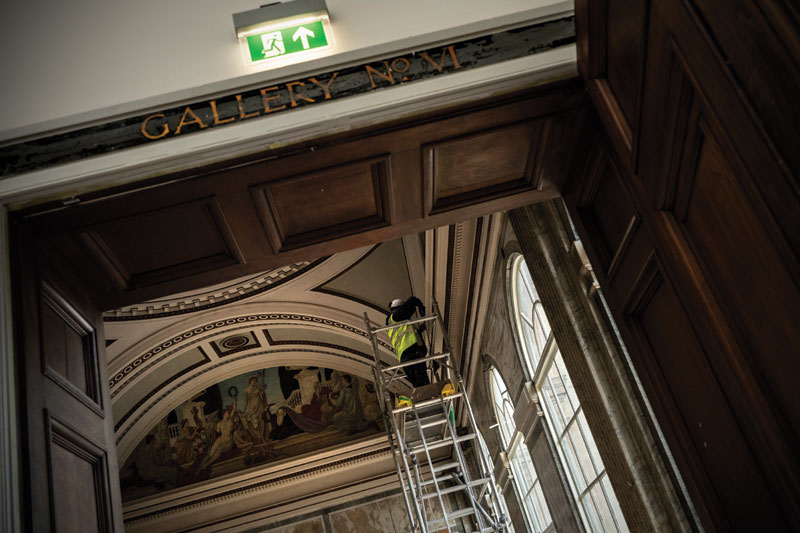
As we make our way down to the lower floors, passing piles of debris en route, the list of accessible facilities continues to grow. Next door to the new family room is a bathroom equipped with an adult changing table, hoist and wet room. “These facilities are essential to a lot of families in enabling them to come out,” says Alison. “Because they are so important, there is a map of all the ones in the country – and there are only two others in the city centre – one at Cabot and one at We The Curious. We’ll be the only art gallery between St Ives, London and Leicester that has one. It is estimated that there are 66,000 children and young people with disabilities within an hour of Bristol and and now many will be able to visit an art gallery for the first time and explore their creativity.”
Beyond this space is a quiet room fitted with bean bags for people with sensory issues, a classroom and a lunch room for vulnerable people. What’s more, a gallery space has been redesigned to house the artwork of local community groups from various parts of Bristol. “We put on monthly workshops in Easton, Redcliffe, Southmead and Hartcliffe,” Alison explains. “This new space will showcase their brilliant work.”
Since the gallery temporarily closed its doors, its collections have been kept in a safe unit away from the build. As the team now begins to welcome their permanent pieces back, they look forward to hosting their first exhibition of 2022 – Me, Myself, I: Artists’ Self-Portraits. Curated by internationally acclaimed and Bristol-based curator, artistic director and writer, Tessa Jackson OBE, the exhibition uniquely sets the context for a specific exploration around how artists have approached self-portraiture in the last fifty years, how the genre reflects society at the time and the concerns we have been collectively engaged with. Featuring over 80 works of artists from the last 300 years – including Grayson Perry, Tracey Emin, Sonia Boyce, Antony Gormley and Sir Joshua Reynolds – the works will provide historical context to today’s selfie culture.
Curator Tessa Jackson said: “Whilst the selfie is a relatively recent phenomenon in our visual culture, our fascination with self-representation has existed for hundreds of years in art history. Self-portraits reveal so much about the artist and how they wished to be seen, as well as the society they lived in and the preoccupations of their time.
“I’m thrilled that the exhibition will be the first one to take place in the stunning and newly transformed galleries of the RWA, following the completion of the most significant refurbishment of the building in over a hundred years. I hope that it will play its part in encouraging greater and more diverse audiences to the galleries, welcoming returning visitors and new ones to enjoy the exhibition and spark thought and discussion.”
Along with the refurbishment comes new pieces of world-class artwork for the gallery’s permanent collection, all of which will not only adorn the indoor galleries but, for the first time, the outside walls of the historical building. Earlier this year, renowned British artist and sculptor Peter Randall-Page was commissioned to design a piece of exterior cladding that would wrap around the newly built lift shaft. An RWA Academician – and Royal Academician – for many years, Randall-Page is known for his stone sculpture work, inspired by geometric patterns from nature. Perhaps his most well-known piece is the Seed sculpture, which sits as part of the Eden Project in a specially designed chamber at the heart of the Core building, but beyond that, his collaboration with Dulwich College in south-east London saw his thoughtful cladding designs for the public school’s science building win a RIBA London Award and RIBA National Award for his significant contribution to architecture.
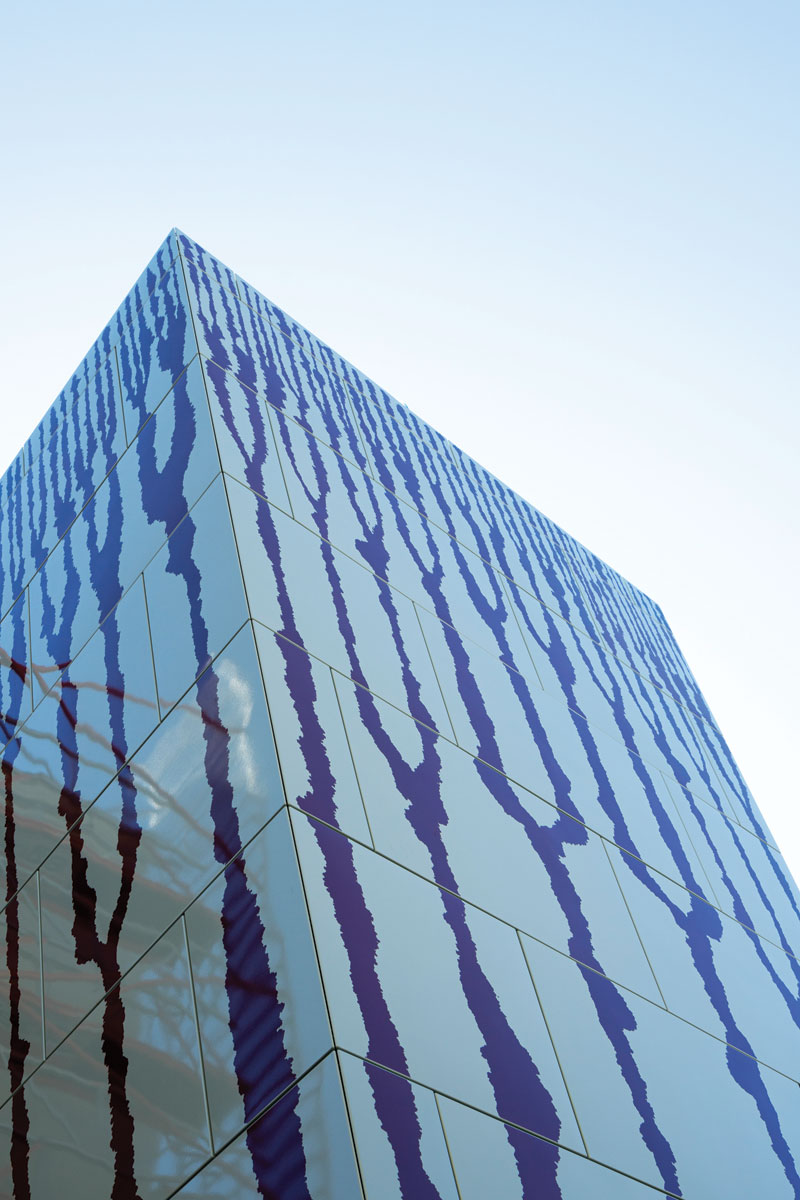
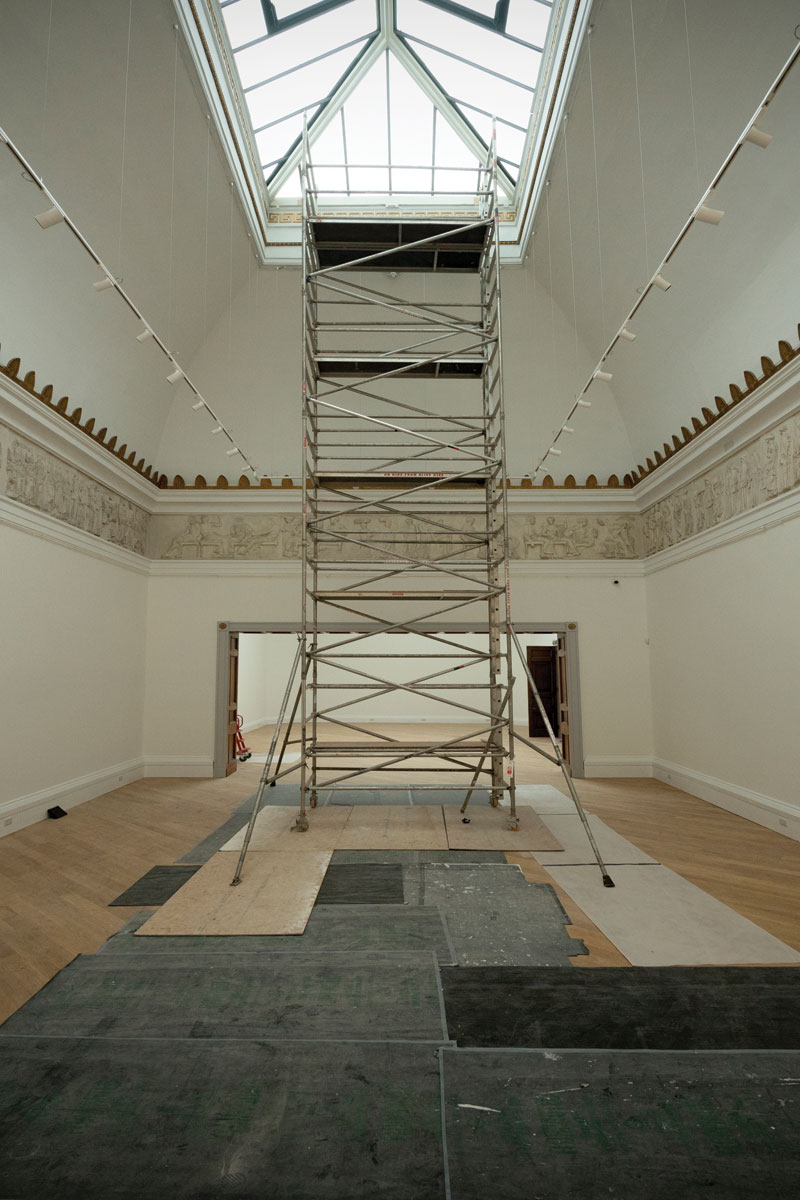
Alison explains how the commission came to fruition: “Originally, the architect was going to design some plain cladding, but because we’re an art gallery and a Grade II* listed building, we wanted to make sure it was aesthetically right for us. When the Art Fund gave us a commissioning grant, we were able to pay the difference between using a bog-standard piece of cladding and us employing Peter to do the design. The beauty of the enamel, which is made by a company called AJ Wells based in the Isle of Wight, who create all of London Underground’s signage and other architectural cladding, is that it has an exceptionally durable surface finish. It’s a practical solution and I think it looks exquisite.”
Of course, this renovation could not have been completed without the generous help of local trusts and supporters. “I would like to particularly thank the John James Bristol Foundation and the Nisbett Trust,” says Alison. “They are local families that have put in a lot of money to help us get this done.”
In its details, the care and attention poured into this restoration shines through. It is clear to see that the building has been handled sensitively, which perfectly masks the more modern elements that were needed to make it an accessible and rewarding space for all. Ultimately, it’s the return of one of the city’s most-loved creative spaces, feeling familiar but fresh. Welcome back, RWA, we’ve missed you.
The Family Activity Space, shop and Kenny Gallery are free entry, with tickets to the main exhibition £8.90, or free for under 21s, students, RWA Friends and Art Pass Holders. The exhibition opens to the public on bank holiday Monday (2 May). It will open on 30 April and 1 May for patrons, friends, academicians and Artist Network Members. Tickets available at: rwa.org.uk/collections/events


